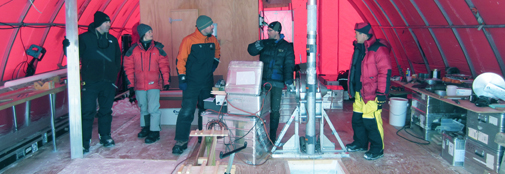Outside the wind blows; but we are all busy inside

Loggers and drillers in the storage garage where the 420 m ice core is drilled.
From left: Tyler, Michelle, Darcy, Trevor and Andrew.
Again, our forecasters were spot on. Strong winds came to camp this morning; but we were prepared, and work could progress in the shelter of our weatherports and down in the trenches.
Today, the CFA system went on-line and with core processing beginning yesterday, the scientific program has got a good start.
A further sign of progress is that the drillers announced that they will change to “wet” drilling mode. When we drill an intermediate depth core, like the present 420m, we prefer to drill with the drill immersed in a 10 m column of drilling fluid. The fluid helps chip transport, lubricates the drilling process and removes the tendency of ice cores from depths deeper than 100 m to fracture and crack. We can only use fluid at depths larger than 90 m, because the porous firn, i.e. compressed snow, turns into non-porous glacier ice at this depth and the fluid will no longer seep away into the snow pack, but will be contained in the hole.
What we have done today:
1. Drilling and logging. In two shifts. Drillers now going to wet drilling
mode. Depth 87.7 m.
2. Processing NEEM deep core brittle zone, bags 1882-1904 (1034.55m –
1047.20m).
3. Measuring by CFA. All CFA systems running. Measured 2.2 m. Depth 2202.75m
4. Setting up U.S. borehole logging equipment.
5. In preparation for wet drilling, Martin repaired the chip centrifuge.
Drillers report: In the last couple of runs, the cores began to show the flaky breaks along the axis. After consulting with Sepp on the firn/ice transition, we decided to switch to “wet” mode.
Tonight 130 liter of fluid was placed in the hole, and we began mounting the wet drill head and modifying the hollow shaft. The test of the new drill head has been successful, and by using it we have avoided the need to ream the hole to larger diameter.
Weather: Clear all day. Temp. - 17 °C to - 22 °C, 20 knots from ESE.
Visibility 1-5 miles, slight blowing snow.
FL, J.P. Steffensen
| ← Previous entry | Next entry → |

